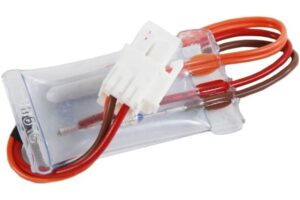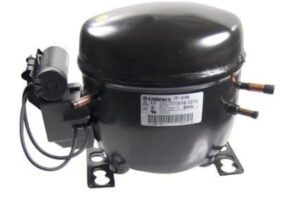Step into your kitchen, eagerly anticipating a scoop of your favorite ice cream, only to be met with an unexpected blast of warm air from your freezer.

It’s a chilling dilemma that can leave you feeling perplexed and, dare we say, defrosted. Fear not, as we unravel the mystery behind your freezer’s unexpected warm welcome.
Our freezers, the silent guardians of our culinary treasures, wield the power to transform the mundane into the extraordinary.
But when warmth replaces the familiar chill, it’s time to embark on a journey through the inner workings of this indispensable appliance.
From the intricate dance of temperature settings to the potential melodrama of refrigerant leaks, we are your guides through the maze of causes and solutions.
Common Causes of a Freezer Blowing Warm Air
1. Incorrect Temperature Settings
Overview of Temperature Control Settings
Understanding why your freezer misbehaves starts with the seemingly simple realm of temperature control settings.
Your freezer, much like a thermostat for your home, has settings that dictate its internal climate. These controls can sometimes be nudged in the wrong direction, leading to a less-than-frosty outcome.
How to Check and Adjust Settings
Locate the temperature control settings on your freezer – this information is often found in the user manual. Take a moment to ensure they haven’t been accidentally shifted.
If adjustments are needed, set the temperature to a colder level and give your freezer time to recalibrate. A minor tweak here could be the key to restoring its calm composure.
2. Door Seal Issues
Importance of a Sealed Door for Temperature Control
Consider your freezer’s door seal as the guardian of its chilly realm. A compromised seal allows warm air infiltration, disrupting the carefully maintained temperature.
Over time, wear and tear or accidental damage can compromise this crucial barrier.
Inspection and Replacement of Damaged Door Seals
Inspect the door seals for visible gaps or damage. If you spot any issues, it’s time to replace the seals. Refer to your user manual for guidance on proper replacement procedures.
Think of it as giving your freezer armor to defend against the warmth trying to sneak in.
3. Condenser Coils
Explanation of Condenser Coils
These coils are pivotal in dissipating heat, ensuring your freezer stays frosty. However, their efficiency can be hindered by a layer of dust and grime.
Cleaning Tips to Maintain Efficiency
Equip yourself with a vacuum cleaner or a coil brush and gently clean the condenser coils. Always unplug the freezer before starting this maintenance task.
Think of it as giving your freezer a spa day – a little attention to its coils can do wonders for overall well-being.
4. Defrost System Malfunction

How a Malfunction Can Lead to Warm Air
Your freezer attempting a delicate ballet of defrosting to maintain its icy equilibrium. A malfunction in this process can result in excessive ice buildup, obstructing proper airflow and leading to warmer temperatures.
Testing and Replacing Defrost Components
Become a freezer detective by testing the defrost thermostat, heater, and timer.
If any of these components show signs of malfunction, consider replacing them to restore the delicate dance of defrosting that keeps your freezer at the optimal temperature.
Refrigerant Leaks and Fan Malfunctions
1. Refrigerant Leaks
Impact on Temperature Regulation
Refrigerant is the lifeblood of your freezer’s cooling system. When there’s a leak, it’s akin to a slow, silent drain on its vitality. The result? Room-temperature air circulates through your once-icy haven.
Signs of a Refrigerant Leak
Keep an eye out for telltale signs such as a noticeable decrease in cooling efficiency, strange hissing sounds, or a unit that seems to be working overtime without the expected results.
If any of these symptoms arise, it’s time to consider a refrigerant leak as a potential culprit.
Professional Repair and Refrigerant Refill
Addressing refrigerant issues requires the skilled hands of a professional technician. They’ll diagnose the source of the leak, fix it, and then refill the refrigerant to the optimal level.
This isn’t a DIY endeavor; it’s a job for the experts to ensure your freezer’s recovery.
2. Fan and Ventilation Issues
Evaporator and Condenser Fan Problems
Understanding the symphony of fans within your freezer is crucial. Both the evaporator and condenser fans play vital roles in maintaining proper airflow.
Malfunctions in these components can disrupt the delicate balance of cold air circulation.
Checking and Replacing Malfunctioning Fans
Conduct a thorough inspection of the fans. Listen for unusual noises or observe any lack of movement. If you detect issues, it’s time to replace the malfunctioning fan promptly.
Think of it as orchestrating a harmonious airflow performance within your freezer.
3. Blocked Vents
Airflow between Freezer and Fridge
Picture your freezer as the conductor of a chilly orchestra, with cold air flowing into the fridge through well-designed vents.
If these vents are blocked, the symphony becomes a discordant cacophony, and your fridge may not be as cool as it should be.
Identifying and Clearing Obstructions
Inspect the vents for obstructions – perhaps a bag of frozen peas or a forgotten ice cream container blocking the airflow. Ensure no items hinder the seamless exchange of cold air between the freezer and the fridge compartments.
Defrost Heater Malfunction and Safety Concerns
1. Defrost Heater Malfunction
Imagine your freezer’s defrost heater as the backstage crew working tirelessly to ensure the main act runs smoothly.
If this crucial component malfunctions, it can become a heat source instead of contributing to the graceful defrosting dance. The result? Excessive heat that infiltrates your freezer.
Testing and Replacing Defrost Heaters
Become a backstage technician by testing the defrost heater for proper functioning. If you notice any irregularities, such as overheating or continuous operation, it’s time to replace the defrost heater.
Remember to check the timer, ensuring it allows the heater to operate in well-timed intervals.
Timer Issues and Their Impact
A malfunctioning timer can throw off the entire defrosting schedule, causing the heater to operate continuously.
Replace the timer if it’s stuck or shows signs of electrical shorts. This ensures the delicate balance of defrosting and cooling is maintained.
2. Safety Concerns
Fire Hazards Associated with Malfunctioning Appliances
When appliances go awry, especially those involving heating elements like defrost heaters, the risk of a fire hazard increases.
It’s not just about a warmer freezer; it’s about potential safety concerns that demand immediate attention.
Importance of Addressing Issues Promptly
Timely intervention is crucial. Not only does addressing issues promptly prevent further damage to your freezer, but it also ensures the safety of your home and loved ones.
A malfunctioning appliance can escalate beyond inconvenience and become a severe hazard.
Compressor and Condenser Issues: Unraveling the Source of Hot Air

1. Can the Compressor or Condenser Be the Culprit?
The compressor and condenser are the powerhouse duo responsible for circulating refrigerant and maintaining the freezer’s desired temperature.
However, if either component is compromised, it could lead to your freezer blowing warm air.
Overheating Scenarios
In rare instances, the compressor or condenser may continue running without refrigerant, causing it to overheat. This not only results in a warmer freezer but also poses potential risks.
Taking Swift Action
If you suspect an issue with the compressor or condenser, unplug your freezer immediately. Running these components without refrigerant can lead to severe damage. Once unplugged, it’s time to call for professional service.
2. The Critical Step: Unplugging and Seeking Professional Assistance
Unplugging for Safety
Unplugging your freezer is critical in preventing further damage and ensuring your safety. In case of suspected compressor or condenser issues, it’s a necessary precaution.
Calling for Professional Service
Addressing compressor or condenser issues requires the expertise of a trained technician.
Attempting to troubleshoot or repair these components without proper knowledge can lead to more harm than good. Call for professional service promptly.
Conclusion
As we conclude our guide, remember that once plagued by warm air, your freezer has the potential for a chilly renaissance.
By understanding the intricacies of its components, recognizing warning signs, and taking prompt action, you become the guardian of your freezer’s well-being.
Whether adjusting temperature settings, replacing door seals, or seeking professional assistance for complex issues, your freezer’s redemption lies in your hands.
Equip yourself with the knowledge gained from this guide, and let the cool vibes return to your kitchen.
